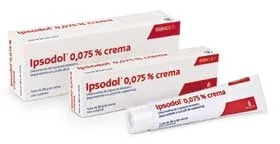

ІПСОДОЛ 0,075% КРЕМ

Запитайте лікаря про рецепт на ІПСОДОЛ 0,075% КРЕМ

Інструкція із застосування ІПСОДОЛ 0,075% КРЕМ
Вступ
Опис: інформація для користувача
Іпсодол 0,075% крем
Олеорезина Capsicum annuumL.(еквівалентна капсаїцину 0,075%)
Прочитайте уважно весь опис перед початком використання цього лікарського засобу, оскільки він містить важливу інформацію для вас.
- Збережіть цей опис, оскільки вам може знадобитися знову його прочитати. Якщо у вас виникнуть питання, проконсультуйтеся з вашим лікарем або фармацевтом.
- Цей лікарський засіб призначений тільки вам, і не слід давати його іншим людям, навіть якщо вони мають相同ні симптоми, оскільки це може їм нашкодити.
- Якщо ви відчуваєте побічні ефекти, проконсультуйтеся з вашим лікарем або фармацевтом, навіть якщо це побічні ефекти, які не вказані в цьому описі. Див. розділ 4.
Зміст опису
- Що таке Іпсодол крем і для чого він використовується
- Що потрібно знати перед початком використання Іпсодол крему
- Як використовувати Іпсодол крем
- Можливі побічні ефекти
- Збереження Іпсодол крему
- Зміст упаковки та додаткова інформація
1. Що таке Іпсодол крем і для чого він використовується
Іпсодол крем містить олеорезину Capsicum annuumL., яка є анестезуючим засобом місцевої дії.
Він використовується для полегшення помірного до сильного болю в діабетичній нейропатії, який заважає щоденним заняттям і не відповідає на інше лікування.
2. Що потрібно знати перед початком використання Іпсодол крему
Не використовувати Іпсодол крем
Якщо ви алергічні на олеорезину Capsicum annuum L.або на будь-який інший компонент цього лікарського засобу (включно з розділом 6).
Попередження та обережність
Проконсультуйтеся з вашим лікарем або фармацевтом перед початком використання Іпсодол крему.
Цей лікування повинно бути призначено і контролюватися спеціалістом, який лікує діабетичних пацієнтів. Це препарат використовується тільки зовні. Не застосовуйте на пошкодженій шкірі або ранах. Це лікарський засіб дуже подразнює. Уникайте контакту з очима і слизистими оболонками. Для цього рекомендується завжди мити руки холодною водою і мильним засобом одразу після кожної застосування, і, якщо лікар не вказав інакше, уникайте застосування крему біля очей або на слизистих оболонках (наприклад, у роті). Контакт з очима або іншими слизистими оболонками може викликати відчуття печіння. Якщо це відбувається, промийте область великою кількістю холодної води.
Коли обробляється область рук, пацієнти не повинні мити руки протягом至少 30 хвилин після застосування. Під час цього часу слід контролювати випадковий контакт з чутливими зонами.
Якщо біль триває або погіршується після перших 2 тижнів лікування або зникає і знову з'являється через кілька днів, або з'являється надмірна подразнення, зупиніть лікування і проконсультуйтеся з лікарем.
Не застосовуйте тепло ні тугі пов'язки на оброблюваній області. Не використовувати тривало ні на великих площах.
Використання Іпсодол з іншими лікарськими засобами
Можливі взаємодії цього препарату з іншими місцевими лікарськими засобами не відомі.
Оскільки це лікарський засіб для зовнішнього використання, не очікується взаємодія з іншими системними лікарськими засобами.
Повідомте вашому лікареві або фармацевту, якщо ви використовуєте, використовували нещодавно або можете використовувати будь-який інший лікарський засіб.
Вагітність і годування грудьми
Якщо ви вагітні або годуєте грудьми, вважаєте, що можете бути вагітною або плануєте вагітність, проконсультуйтеся з вашим лікарем або фармацевтом перед використанням цього лікарського засобу.
Якщо ви вагітні, ваш лікар визначить доцільність початку цього лікування.
Аналогічно, якщо ви годуєте грудьми, ваш лікар визначить доцільність початку лікування цим лікарським засобом.
Водіння транспортних засобів і використання машин
Використання лікарського засобу не впливає на здатність водіння транспортних засобів і використання машин.
Іпсодол містить пропіленгліколь (Е-1520), цетиловий спирт, метилпараабен, натрієву сіль (Е-219) і пропілпараабен, натрієву сіль (Е-217).
Цей лікарський засіб містить 5 г пропіленгліколю (Е-1520) на кожні 100 г крему. Пропіленгліколь може викликати подразнення шкіри.
Може викликати алергічні реакції (можливо, затримані) через наявність метилпараабену, натрієвої солі (Е-219) і пропілпараабену, натрієвої солі (Е-217).
Цей лікарський засіб може викликати місцеві реакції на шкірі (наприклад, контактний дерматит) через наявність цетилового спирту.
3. Як використовувати Іпсодол крем
Слідуйте точно інструкціям щодо застосування цього лікарського засобу, вказаним вашим лікарем або фармацевтом. У разі сумнівів проконсультуйтеся з вашим лікарем або фармацевтом.
Іпсодол крем є лікарським засобом для зовнішнього використання лише зовні. Його слід наносити на больові області шкіри.
Використання у дорослих і осіб похилого віку:
Нормальна доза становить три-чотири застосування на добу протягом 8 тижнів, після чого лікар визначить припинення або продовження лікування.
Використання у дітей:
Не рекомендується.
Слідуйте цим інструкціям, якщо тільки ваш лікар не дав вам інших вказівок.
Нанесіть мінімальну кількість крему, необхідну для покриття больової області шкіри.
Розтирайте крем масажними рухами до повного всмоктування, уникайте залишків.
Важливо робити застосування щоденно.
Тривалість лікування складатиме 8 тижнів, після чого лікар визначить припинення або продовження лікування.
Ваш лікар вказує тривалість вашого лікування Іпсодол кремом.
Якщо ви використовуєте більше Іпсодол крему, ніж потрібно
Гостра інтоксикація практично неможлива при правильному використанні лікарського засобу.
У разі передозування або випадкового прийому всередину, або контакту з очима, негайно проконсультуйтеся з вашим лікарем або фармацевтом або зверніться до служби токсикологічної інформації за телефоном 91 562 04 20, вказавши лікарський засіб і кількість, прийняту всередину.
Якщо ви забули використовувати Іпсодол крем
Не застосовуйте подвійну дозу для компенсації забутих доз.
Продовжуйте лікування з рекомендованою посологією.
Якщо у вас виникли інші питання щодо використання цього лікарського засобу, проконсультуйтеся з вашим лікарем або фармацевтом.
4. Можливі побічні ефекти
Як і всі лікарські засоби, Іпсодол крем може викликати побічні ефекти, хоча не всі люди їх відчувають.
Під час перших днів лікування може з'явитися відчуття печіння або свербіння на шкірі в місці застосування в пропорції близько 50% випадків. Ця реакція, яка є відомою, є наслідком фармакологічної дії капсаїцину, коли він вивільняє речовину Р з периферичних нервових закінчень і накопичується в синапсі, і зазвичай зникає або зменшується з часом при тривалому лікуванні в рекомендованій дозі, без необхідності припинення лікування. Тривалість і інтенсивність цієї реакції можуть бути різними, але можуть тривати, якщо Іпсодол крем застосовується менше 3-4 разів на добу. Гаряча вода, надмірна потіння або окульса можуть посилити це відчуття. Інші можливі побічні ефекти на шкірі можуть бути подразненням і сухістю шкіри в місці застосування.
Під час лікування також можуть з'явитися, у значно меншій пропорції, чхання, слізотеча або кашель (менше 2%), внаслідок інгаляції залишків сухої крему. Тому важливо застосовувати мінімальну кількість крему, необхідну для покриття больової області шкіри, і уникати залишків на шкірі, а також мити руки холодною водою і мильним засобом після застосування.
Якщо ви вважаєте, що будь-який з побічних ефектів, які ви відчуваєте, є серйозним, або якщо ви помітили будь-який побічний ефект, не вказаний в цьому описі, повідомте вашому лікареві або фармацевту.
Повідомлення про побічні ефекти:
Якщо ви відчуваєте будь-який тип побічного ефекту, проконсультуйтеся з вашим лікарем або фармацевтом, навіть якщо це можливі побічні ефекти, які не вказані в цьому описі. Ви також можете повідомити про них безпосередньо через систему фармакологічного моніторингу лікарських засобів для людини: https://www.notificaram.es.
Повідомляючи про побічні ефекти, ви можете допомогти надати більше інформації про безпеку цього лікарського засобу.
5. Збереження Іпсодол крему
Тримайте цей лікарський засіб поза досяжністю дітей.
Не використовувати цей лікарський засіб після закінчення терміну придатності, вказаного на упаковці. Термін придатності закінчується в останній день місяця, вказаного на упаковці.
Не вимагає спеціальних умов зберігання.
Лікарські засоби не слід викидати в каналізацію або сміттєві контейнери. Відкладайте упаковки і лікарські засоби, які вам не потрібні, в спеціальний контейнер для збору відходів в аптеці. У разі сумнівів проконсультуйтеся з вашим фармацевтом, як позбутися упаковок і лікарських засобів, які вам не потрібні. Таким чином, ви допоможете захистити навколишнє середовище.
6. Зміст упаковки та додаткова інформація
Склад Іпсодол крему
- Активний інгредієнт - олеорезина Capsicum annuumL. Кожні 100 г крему містять олеорезину Capsicum annuumL.(312-625 мг) еквівалентну 75 мг капсаїцину.
- Інші компоненти (експіцієнти): поліетиленгліколь-моностеарат, гліцерил-моностеарат, ізопропіл-мірістат, пропіленгліколь (Е-1520), олеїлова кислота, стеаринова кислота, цетиловий спирт, метилпараабен, натрієва сіль (Е-219), пропілпараабен, натрієва сіль (Е-217), очищена вода.
Вигляд Іпсодол крему та вміст упаковки
Крем білого жовтого кольору.
Вміст упаковки - 30 і 50 г.
Уповноважений на отримання дозволу на продаж
ANGELINI PHARMA ESPAÑA, S.L.
c/ Antonio Machado, 78-80
3-я поверх, модуль А-будівля Австралія
08840 Віладеканс, Барселона (Іспанія)
Виробник
Especialidades Farmacéuticas Centrum, S.A.
C/ Sagitario, нº 14
03006 – Аліканте (Іспанія)
Дата останнього перегляду цього опису:Серпень 2013
Детальна і актуальна інформація про цей лікарський засіб доступна на сайті Іспанського агентства лікарських засобів і медичних продуктів (AEMPS) http://www.aemps.gob.es

Скільки коштує ІПСОДОЛ 0,075% КРЕМ в Іспанії у 2025 році?
ІПСОДОЛ 0,075% КРЕМ коштує в середньому 12.91 євро у листопад, 2025 році. Ціна може змінюватися залежно від регіону, аптеки та наявності рецепта. Рекомендуємо перевіряти актуальну вартість у місцевих аптеках або через онлайн-сервіси.
- Країна реєстрації
- Середня ціна в аптеках12.91 EUR
- Діючі речовини
- Потрібен рецептТак
- Виробник
- Інформація є довідковою і не є медичною порадою. Перед прийомом будь-яких препаратів обов'язково проконсультуйтеся з лікарем. Oladoctor не несе відповідальності за медичні рішення, прийняті на основі цього контенту.
- Альтернативи до ІПСОДОЛ 0,075% КРЕМФорма випуску: КРЕМ, 0.075% Капсаїцин (30 та 50 г крему)Діючі речовини: capsaicinВиробник: Alfasigma Espana S.L.Потрібен рецептФорма випуску: КРЕМ, 0,075 г капсаїцинуДіючі речовини: capsaicinВиробник: Laboratorios Vinas S.A.Потрібен рецептФорма випуску: КРЕМ, 75 мг капсаїцину / 100 г кремуДіючі речовини: capsaicinВиробник: Arafarma Group S.A.Потрібен рецепт
Лікарі онлайн щодо ІПСОДОЛ 0,075% КРЕМ
Консультація щодо дозування, побічних ефектів, взаємодій, протипоказань та поновлення рецепта на ІПСОДОЛ 0,075% КРЕМ – за рішенням лікаря та згідно з місцевими правилами.














